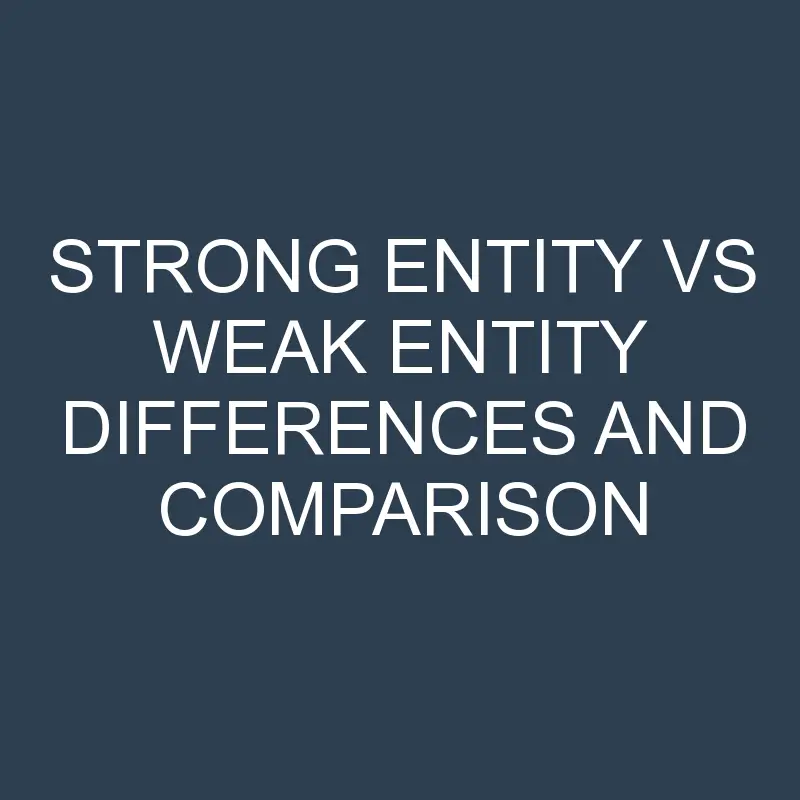
Post Contents
Overview: Strong Entity VS Weak Entity
The basic object that ER model represents is an entity.an entity can be defined as something that exists in the real world.an entity may be an object into the physical existence for example a car, house, person, employee or it may be an object with a physical existence. a database usually consists groups of entities that are similar. For example, a company employing hundreds of employees may want to have the similar information concerning each of the employees.
These employee’s entries share the same attribute, but each of them has its own value for each attribute.an entity type defines a collection of entities that have the same attributes. Each entity type in a database is described by its name and its value.
The collection of the entities of a particular entity type in the database at any point is called as the entity set.an entity is represented in an ER diagram as an rectangular box enclosing the entity type name.
The entity is classified into strong entity and weak entity. So now let’s talk about the difference between the two.
What is Strong Entity?
A regular entity type that have a key value is said to be as the strong entity. A strong entity doesn’t depend on any entity in the schema.it is always independent. these types of entity are represented using a rectangle box.in case of strong entity it will be definitely having a primary key. Whenever there is a strong relationship between the two strong entities it will be represented using a diamond.
let’s take the example of an employee.it is not necessary for an employ to have a family but is necessary for every family to have an employee.in short we can say that a strong entity doesn’t have to depend on any entity. It is in depended in itself.
What is Weak Entity?
Entity types that do not have key attributes of there on is said to be as weak entity. Entities that belong to the weak entity type is identified by being related to specific entities from another entity in combination with one of their attribute value.
A weak entity on the other hand is something that is depended on the strong entity. Weak entities can sometimes be represented as complex. The choice of the representation to use is made by the database designer. In general, we can say that any number of levels of the weak entity types can be defined.
Let’s take an example of a customer who takes a loan from the bank, here the customer is a strong entity, and the loan is a weak entity because without the customer the loan cannot be taken. But a loan can be taken by any customer .so here the loan is a weak entity which has a relation with a strong entity. A weak entity will not hold a primary key compared to the strong entity. The weak entity is usually represented by a double rectangle. On contrary the weak entity has a partial discriminator key compared to a strong entity.
Comparison Table
| Basics of Difference | Weak Entity | Strong Entity |
|---|---|---|
| Key | The key has partial discriminator key | The key is a primary key |
| Dependence | Dependent on strong entity | It is an independent |
| Representation | Represented by double rectangle | Represented by single rectangle |
| Participation | Total participation | Either total participation or not |
| Relation | Relationship between strong and weak entity is usually Denoted by double diamond | Relationship between two strong entities is usually Denoted by a single diamond |
Pivot differences
- The key difference between these two entity is that in strong entity it has a primary key where as in case of a weak entity it has a partial discrimination key.
- A strong entity is in depended of its existence compared to the weak entity. Because in case of the weak entity it always depends on the strong entity for its existence.
- The representation of the strong entity is by a single rectangle whereas in case of the weak entity it is represented by using a double rectangle.
- Participation in the relation of a strong entity may or may not be showing whereas the participation of the weak entity always shows.
Conclusion
It’s very easy to understand that a weak entity always depends upon a strong entity whereas the strong entity is independent of any entity. as per the identification part of strong and weak entity in dbms the strong entity could be easily identified by a primary key whereas a weak entity is identified by a partial discrimination key.
